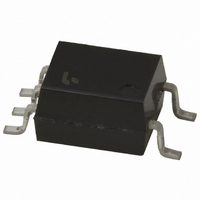TLP130(GB,F) Toshiba, TLP130(GB,F) Datasheet

TLP130(GB,F)
Specifications of TLP130(GB,F)
Related parts for TLP130(GB,F)
TLP130(GB,F) Summary of contents
Page 1
... TOSHIBA Photocoupler GaAs Ired & Photo−Transistor Programmable Controllers AC / DC−Input Module Telecommunication The TOSHIBA mini flat coupler TLP130 is a small outline coupler, suitable for surface mount assembly. TLP130 consists of a photo transistor, optically coupled to two gallium arsenide infrared emitting diode connected inverse parallel, and operate directly by AC input current. • ...
Page 2
... Please design the appropriate reliability upon reviewing the Toshiba Semiconductor Reliability Handbook (“Handling Precautions”/“Derating Concept and Methods”) and individual reliability data (i.e. reliability test report and estimated failure rate, etc). ...
Page 3
Individual Electrical Characteristics Characteristic Forward voltage Capacitance Collector−emitter breakdown voltage Emitter−collector breakdown voltage Collector−base breakdown voltage Emitter−base breakdown voltage Collector dark current Collector dark current Collector dark current DC forward current gain Capacitance collector to emitter Coupled Electrical Characteristics Characteristic ...
Page 4
Isolation Characteristics Characteristic Capacitance input to output Isolation resistance Isolation voltage Switching Characteristics Characteristic Rise time Fall time Turn−on time Turn−off time Turn−on time Storage time Turn-off time Turn−on time Storage time Turn-off time Fig. 1 Switching time test circuit ...
Page 5
I – 100 − Ambient temperature Ta (°C) I – 3000 Pulse width ≤ 100μ 25°C 1000 500 300 100 ...
Page 6
I – 25°C 50mA 40 30mA 20mA 15mA 30 10mA 5mA Collector–emitter voltage – 100 Ta = 25°C ...
Page 7
I – Ta CEO 48V CE 24V 10V − − − − Ambient temperature Ta (°C) I – 100 ...
Page 8
Switching Time – 1000 Ta = 25° 16mA 500 1.9kΩ 300 100 t OFF 100k 300k ...
Page 9
... Product shall not be used for or incorporated into any products or systems whose manufacture, use, or sale is prohibited under any applicable laws or regulations. • The information contained herein is presented only as guidance for Product use. No responsibility is assumed by TOSHIBA for any infringement of patents or any other intellectual property rights of third parties that may result from the use of Product. No license to any intellectual property right is granted by this document, whether express or implied, by estoppel or otherwise. • ...











